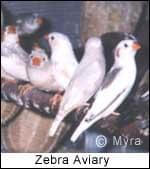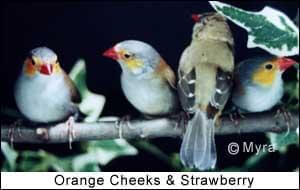Multispecies Cohabitation
..yes you can keep a variety of species together
by Myra
Articles and Information - Lady Gouldian Finch
 Myra Markely (FinchNiche) photo of Zebra Aviary
Myra Markely (FinchNiche) photo of Zebra Aviary
There is no one trick or tip I can give you to housing finches of various species together. Many factors will determine just how well your flock will live together. Knowing the various factors that to play key roles in the harmony of aviary will help you create the best possible living environment for your finches. Always do some research in to any species you plan to buy before buying it.
Species Size: Finches come in a wide range of sizes and temperaments. You can prefer the more laid back demeanor of the Gouldian or Java Rice finches, or perhaps the constant flittering of the Owls and Zebras. It's generally best to keep similarly sized finches an aviary together. If you decide on Owls then stick with other species that have about the same over-all body size. There are instances in which you may be able to house a larger species with a smaller one. There are many rather docile larger finches to choose from. These finches are your Gouldians, Masked Grassfinches and European Goldfinches. When you do decide to add in a larger species only add in a few so they never become the majority of the aviary population.
Species Behavior: Now that size is out of the way you need to think about the various species behavior. The behavior/temperament aspect should always be given consideration, especially if you plan to hang nests in your aviary. I've heard it said that the smaller species are more active and jumpy. This isn't always as true as you may think. Granted some of the more commonly kept larger species such as Gouldians, Red Heads and Java's are less active than the tiny waxbills, however the Goldfinches, Saffrons and Bull finches can be quite active. Knowing your finch's behavior during breeding and non-breeding seasons is very important. Many species will change their behavior during the breeding season even if you don't plan to breed them and provide no nests.
Other species simply do not like to share their space with other species at all. These would be the aggressive Weavers, Melbas, Lavender Waxbills, Combassous and Pekin Robins. The personalities of these finches is often described as tough because they can be very tough on any other finches housed with them. They tend to be very territorial and aggressive, especially when breeding. Often these species will not tolerate others of their own species in the aviary with them.
There are the odd species that need special consideration before you add them to your aviary. These would be the Weavers and the Whydahs. Weaver males are extremely territorial when in their orange and black mating plumage. Weavers are also harem breeders so housing them 1 male per 8 females with no other species is ideal for breeding. Never put two male weavers in the same aviary.
The Whydahs are less aggressive but have parasitical breeding habits that require you house them with either St. Helena Waxbills, Orange Cheek Waxbills, or sometimes even Society finches. Whydahs will not care for their own eggs or chicks. They lay their eggs in other birds' nests and will have nothing more to do with them. If they do return to the nest it may only be to eat some of the foster birds own eggs. While they aren't as aggressive as the weaver males it is still unwise to house 2 male whydahs in the same aviary.
 Orange Cheek Waxbills and Strawberry Finch by Myra (FinchNiche)
Orange Cheek Waxbills and Strawberry Finch by Myra (FinchNiche)
Species Color: Yes now you must take in to consideration all the pretty colors your finches are and in some cases what color they will be during the breeding season. Yes several species do change color during the breeding seasons. The simple rule to follow here is to never house species with similar color/markings together. This means that housing a Zebra and a Red Cheek Cordon Blue may not work well. Both males of the species use the bright red/orange cheeks to attract their mates and they can view either other as rivals. Now switching out the Red Cheek Cordons for a pair of Blue Cap Cordons can often eliminate any sexual rivalry.
Besides the mating and sex colors you must also consider the overall body color of some species. The Fire Finch is a stunning and bright red finch that will house very well with many small non-red colored finches. For example housing Fire Finches with Melbas or Strawberries is unwise because both have a lot of red coloration. Housing Fire Finches with Owls, Spice and other more neutral colored finches will have much more success.
Aviary Space/Size: Now that you have decided on which species you'd like to house in your aviary it's time to think about the space requirements. It's often safe to say that for each pair of finches you need 2'x2'x2'. This can make your aviary plans balloon up in size very quickly. Lets face it, there are so many species to choose from it's hard to turn some away. So lets say you have selected a group of species that are all rather small and will probably live together without much conflict. If this is the case you may be able to get away with a little less space per pair, but don't push you luck too far on this issue.
Ideally if you keep 4 small-bodied pairs (That's 8 birds) together you should have them in an aviary that is at least 5'x'5'x4'. If you have provided them with sufficient perching options, maybe some swings, fake plants to hide in and nests for breeding they should be very content in this space. As they breed and the offspring fledge you'll find that the aviary will become very crowded very quickly. To keep peace in the flock the chicks will need to be moved to an aviary of their own, or you can find new homes for them. If you decide not to breed your finches and do not provide nests you may be able to get 1-2 more pairs in aviary of this size.
Naturally the larger bodied birds will need more space per pair whether you are going to breed them or not. For these large finches I'd stick with the 2'x2'x2' per pair.
Breeding: To breed or not to breed is always a big question. Honestly it's easier to just sit back and enjoy your finches cheerful company if you do not breed them. I know how "cute" they are in their nests but they really don't need the nests. In fact if you do put nests in and continually pitch the eggs that they lay you will only end up causing them more stress. On the other hand watching those babies hatch and grow in to little birds is always a delight. If you do decide to breed you much be prepared to take control over your aviary. Only provide nests when you want babies. Remove the nests as soon as the babies fledge. Toss excess eggs laid - especially those laid when the nests aren't in. Many finch species will easily and very quickly over-breed themselves if you allow it. This will result in smaller, weaker offspring and will dramatically shorten the life span of the parents.
Diet: Feeding the birds in a multi-species aviary will present you with some interesting challenges, especially if you plan to breed. Yes it always goes back to the breeding factor. All of your finches will enjoy seed & millet as a core diet. Add to it egg food, greens, fruits, and even vegetables to make the diet more well rounded. Now you'll also need to provide some extra high protein foods for the more insectivorous species like Waxbills, Whydahs, Cordons and Weavers. You can do this with a small dish of bug meal, live foods (mealworms, wax worms or maggots) or even Breeders Blend added to the greens or other soft foods.
If you plan to keep Doves or Canaries in your aviary you'll also need to see that their dietary requirements are met. This means adding in Dove food, Canary seed and anything else your birds would normally need. While I'm not a big fan of housing Canaries & Doves with finches it can be done if you take all of their specific requirements in to consideration as you would for any other finch species.
Clutter: There is a fine line between too sparse and cluttered when it comes to adding items to your aviary. A good aviary set-up will allow for ample flight room, plenty of perching options, placed to hide and when breeding sufficient nesting sites. Putting 10 finches in an aviary with a few straight perches, a swing and nests isn't going to work well. Finches need an interesting environment to interact with. Don't be afraid to use various sized and shaped perches, natural branches work very well. Fake or real plants are also ideal as they add a little color and safe places for the birds to hide. Swings and toys also add other unique perching options that are entertaining.
Now don't get too wild putting stuff in your aviary, remember the 'fight space' requirement as you are buying your cage accessories.
Individual Personalities: The last issue I want to cover is individual finch personalities. Each and every bird will have his or her own personality. This is true for all living creatures. Some personalities do very well together while others clash. There is no way to predict with 100% certainty, which finches will get along. Maybe you decide to get several society finches for your aviary, they are friendly and very laid back little birds after all. You may get them all home and after a week notice that one has been singled out and is being plucked. This is rare but it will happen from time to time if you keep finches long enough. This can happen within any species or between species. Individuals of a species that should get along with another species may not. On the flip side you may find that finches that shouldn't get along do.
In the even that a finch is singled out, or has become too aggressive towards the flock be ready to move that bird to another cage. If the bird had been attacked give it time to rest and heal before rejoining the flock. If the bird was the aggressor a little time-out may help or it may not.
Anytime you add or subtract birds from an established flock expect some aggression and fighting. The pecking order, or social order will need to be worked out by the members of the flock each time something changes. The aggression shouldn't last more than a week, if it does be ready to separate birds again.
© lady gouldian finch.com 2017